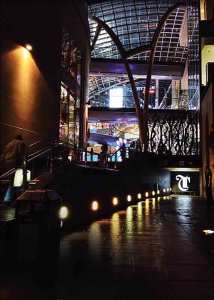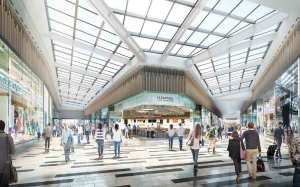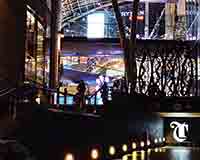 Shiny new storefronts are casting big shadows over the traditional retail pitches of Leeds.
Shiny new storefronts are casting big shadows over the traditional retail pitches of Leeds.
With Land Securities’ 1m sq ft Trinity Leeds deemed a runaway success since it opened in 2013 and Hammerson’s £150m upmarket Victoria Gate hoping to emulate this success when it opens in late 2016 (adding a further 400,000 sq ft of shops, restaurants and a casino), are these new kids on the block pushing former prime areas into the secondary league?
Unsurprisingly, LandSec’s portfolio director, Rob Jewell, says Trinity Leeds has only enhanced the offer: “Trinity Leeds has played an integral role in the resurgence of the Leeds retail market and has acted as a major catalyst for growth and prosperity.”
However, agents paint a different picture. Although they are positive about Trinity, they confirm that it has knocked other pitches. Richard Padley, retail director, national markets at Bilfinger GVA, says: “There are undoubtedly certain secondary pitches in Leeds that won’t recover in their existing or previous use. However, it comes down to having a proactive landlord or adviser who is looking at all options. A huge problem with a lot of secondary retail stock is that they are owned by inactive landlords who are just used to, and happy with, collecting the rent every month.”
Market observers cite Commercial Street as a casualty. Padley says: “Some would argue that Commercial Street has struggled since the opening of Trinity Leeds, taking into account the number of voids on the street. One of the issues is that a number of the empty units still have leases at high passing rents.”
Peter Heron, partner at Sanderson Weatherall, says: “There are six or seven units vacant on the once 100% prime Commercial Street, with retailers such as Phones 4u, Barratts and Santander coming out. The problem is demand is much lower in the retail mid-market. Retail is still tough. Anyone who thinks we’ve come out of recession needs to think again. It’s better than it was, but we’ve still a long way to go.”
Heron puts current zone A rents on Commercial Street at £180-£200 per sq ft, down from a high of £290-£300 per sq ft – a 39% drop that is a bitter pill for any landlord to swallow.
JLL’s Damian Sumner agrees that surrounding pitches such as Commercial Street and Lands Lane have suffered gaps, but says these are now being filled.
James Fox, associate director of retail at CBRE Leeds, adds: “Pitches close to a Trinity entrance have obviously benefitted from Trinity opening and the same is likely to be true of Hammerson’s Victoria Gate. A stretch of Vicar Lane for example will sit directly in between the Victoria Quarter and Victoria Gate and will go from being an edgy pitch to very central.”
Asked how leasing is progressing at Victoria Gate, now under construction, Heron says: “Apart from John Lewis, no one seems to know. Hammerson won’t go into details. We’ve heard no specifics.”
While Hammerson director Robin Dobson confirms around 60% has been let or is in solicitors’ hands, he says only: “We’ll announce the names around our half-year results. We’re still working through the legal process now.”
Patience rewarded in Bradford
 Good things come to those who wait and Bradford shoppers are some of the most patient in the British Isles. Their patience will finally be rewarded later this year, with the long-awaited opening of the 570,000 sq ft Westfield Bradford shopping centre – now rebranded The Broadway Bradford – in autumn.
Good things come to those who wait and Bradford shoppers are some of the most patient in the British Isles. Their patience will finally be rewarded later this year, with the long-awaited opening of the 570,000 sq ft Westfield Bradford shopping centre – now rebranded The Broadway Bradford – in autumn.
The £260m scheme is out of the norm for Westfield, in that after selling its stake to investor Meyer Bergman in 2012 for circa £200m, Westfield is delivering the scheme and managing it on completion, but does not own it – hence the name change.
Word on the street has 31 October as the opening date, but Duncan Bower, Westfield development director, politely declines to confirm.
So in the meantime, will Westfield achieve its preferred full occupancy on opening and will there be a “Westfield effect”, with retailers migrating into the shiny, new retail box?
In February, fashion brand H&M announced it will open a 23,000 sq ft store over three levels, joining anchors Debenhams, Next and M&S, as well as 70 further stores to tenants including River Island, New Look, Boots, JD and Topshop.
Bower confirms lettings are going well. “We’ve got over 30 exchanged deals and around 70% now let, which is what we expect. Our objective is to be fully let on opening. If we do have some voids then we hope that won’t be too obvious.”
Sentiment towards the scheme remains positive. Peter Heron, partner at Sanderson Weatherall, says: “I also think Kirkgate will be fine, there will be the usual voids but that’s natural. My concern is more for Darley Street, as it runs steeply uphill and away from the centre. It’s always been more difficult to let.”
M&S will vacate its existing circa 30,000 sq ft store on Darley Street when it relocates to 60,000 sq ft within The Broadway leaving a gaping void.
Richard Padley, retail director at Bilfinger GVA, adds: “The Kirkgate area of the city and its associated Kirkgate Centre will undoubtedly suffer a ‘Westfield effect’ and see an increase in vacancy rates as the prime pitch is shifted to The Broadway.
“Hopefully this will just be a period of transition while the centre repositions itself in the market.”
Asked about the potential effect on neighbouring retail, Bower says: “A certain amount of change has to be expected. It’s normal to have churn and this provides an opportunity to rebalance the retail mix of the city.”
Bower points to Meyer Bergman’s acquisition last year of the adjacent circa 30,000 sq ft block at 16-20 Broadway, to be developed into more leisure space, which will help form a new streetscape and encourage an evening economy. “We’re just working out proposals now,” he says.











